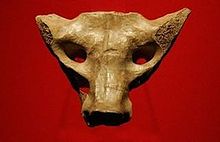| Sacrum bone of Tequixquiac | |
|---|---|
 The sacrum bone of Tequixquiac | |
| Material | Bone |
| Created | 16,000 to 9,000 years |
| Discovered | 1870 Tequixquiac, State of Mexico, Mexico |
| Discovered by | Mariano Barcena |
| Present location | Mexico City, Mexico |
The Sacrum bone of Tequixquiac is an ancient paleo-Indian sculpture carved in a pleistocene-era bone of a prehistoric camelid. It was discovered by Mexican geologist and botanist Mariano de la Bárcena in 1870 in Tequixquiac, Mexico.[1][2] The carving, dated around 14,000 BCE to 7,000 B.C.E., is considered among the earliest pieces of art from the North American continent.[3][2] Although the original purpose of the sculpture is unknown, some scholars have said that the carving held some religious value due to the sacredness of the sacrum bone in later Mesoamerican cultures.[4]
- ^ "Mesoweb Features". www.mesoweb.com. Retrieved 2019-01-15.
- ^ a b Harris, Beth; Zucker, Steven. "Camelid sacrum in the shape of a canine". Khan Academy. Retrieved 2019-01-15.
- ^ de Anda, Luis Aveleyra Arroyo. "The Pleistocene Carved Bone from Tequixquiac, Mexico: A Reappraisal." American Antiquity (1965): 261-277.
- ^ Stross, Brian. "The Mesoamerican Sacrum Bone: Doorway to the Otherworld" (PDF). research.famsi.org. Retrieved January 15, 2019.